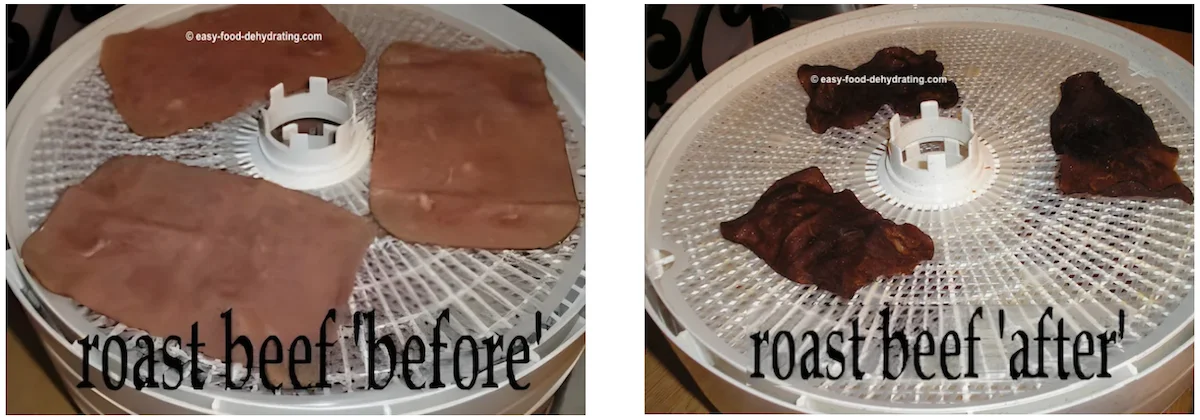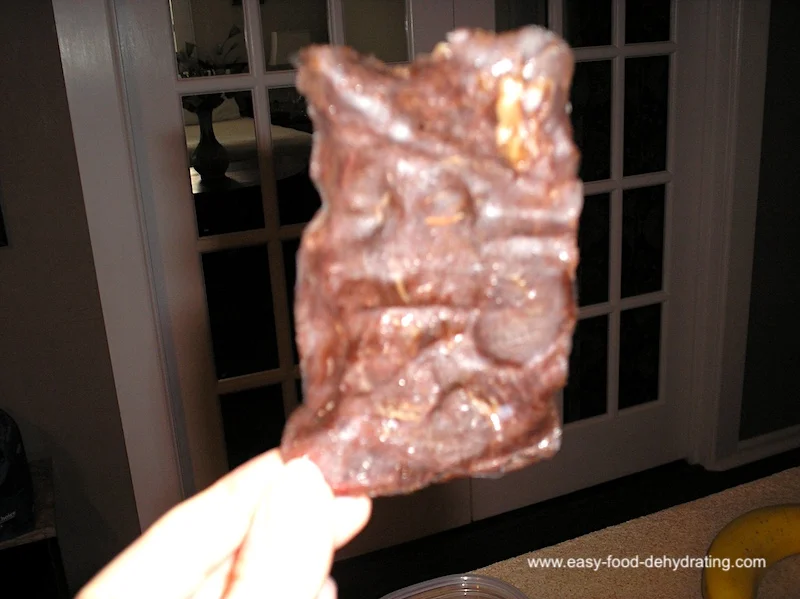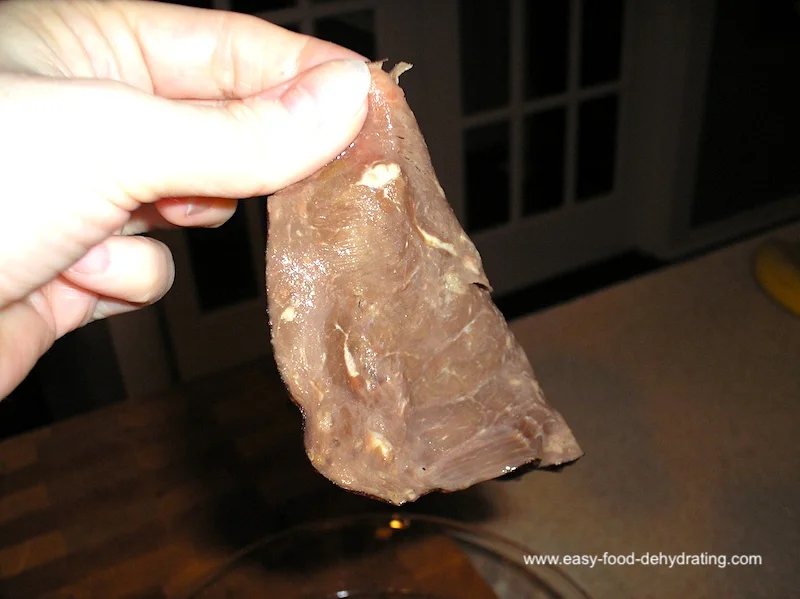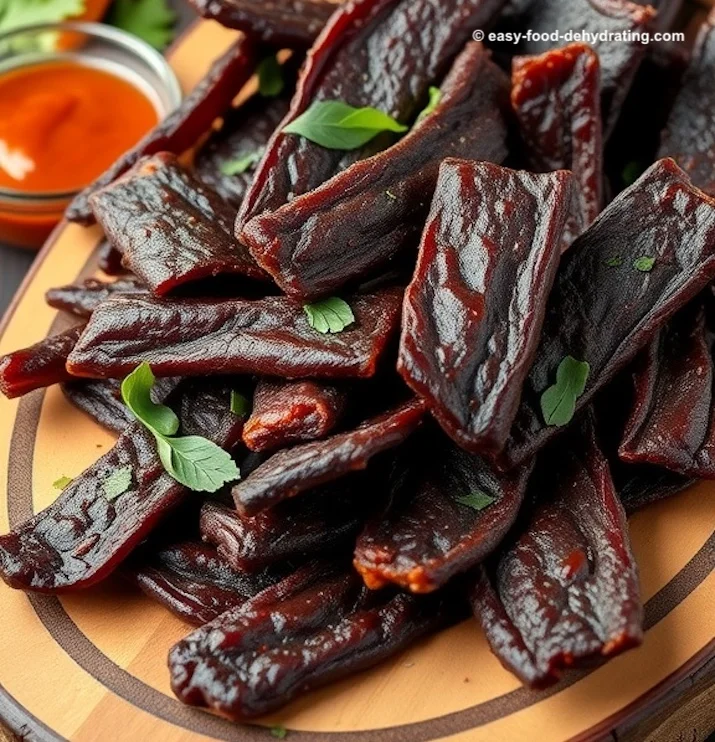What We Mean by “Dehydrate”
Here at Easy Food Dehydrating, “dehydrate” always means using an electric food dehydrator — the easy, reliable way to dry food at home.
- Home
- How to Dehydrate Meat
- How to Dehydrate Beef
How to Dehydrate Beef (Sliced, Safe & So Simple!)

Here's how to dehydrate beef like a pro with this easy step-by-step guide. Whether you’re using leftover roast beef or pre-sliced deli meat, dehydrating beef is a smart way to preserve flavor, save freezer space, and enjoy shelf-stable protein.
✅ Quick Answer: How do you dehydrate beef?
To dehydrate beef, use pre-cooked or roasted beef sliced into even pieces. Place slices on a dehydrator tray and dry at 160°F for about 2 hours, rotating trays halfway through. The beef is done when it feels crisp. Store in vacuum-sealed bags with oxygen absorbers for long-term use.
Let’s walk through the safest methods, rehydration tips, and even a fun jerky recipe you’ll love!
Here are some photos of sliced roast beef on the dehydrator trays before and after dehydrating. Look at how much the roast beef slices shrink!
Shrinkage is completely normal during the dehydration process for most foods.
Sliced Deli Roast Beef BEFORE and AFTER Dehydrating
 Sliced deli Roast Beef before and after dehydrating on a Nesco dehydrator tray
Sliced deli Roast Beef before and after dehydrating on a Nesco dehydrator trayWhy Dehydrating Beef Is a Smart, Long-Term Solution
Let’s get started with dehydrating beef.
If you’re slicing leftover roast beef, try to cut evenly sized pieces—this ensures all slices dry at the same rate.
Shortcut: Pre-Sliced Roast Beef Saves Time
I skip the slicing by buying pre-cooked, pre-sliced roast beef—it saves time and effort!
How to Dehydrate Roast Beef with a Dehydrator
- Arrange slices evenly on your dehydrator trays.
- Don't overlap slices—this ensures even drying.
- Set temperature to 160°F and dehydrate for 2 hours.
- Rotate trays halfway through for even drying (this isn't in the manual, but I do it anyway!).
- Test for doneness: The beef should feel crisp when fully dry.
- Storage: Place dried beef in vacuum-sealer bags with a 100cc oxygen absorber, then remove the air.
💡 Tip: Outside the U.S.? Most dehydrating temps here are listed in Fahrenheit - use our quick converter to see the Celsius equivalent for your machine.
Don’t Have a Dehydrator? Try This Oven Method Instead
- Preheat oven to the lowest setting.
- Place roast beef on a wire rack on the top of a baking sheet.
- Keep the oven door slightly open (use a wooden spoon to prop it open).
- Check beef every few hours—it takes longer than using a dehydrator.
- Remove beef when fully dehydrated.
⚠ Important: We are dehydrating cooked roast beef—not raw beef!
💡 Pro Tip: Dehydrated beef, turkey, and chicken all rehydrate beautifully. I used 7 oz. of pre-cooked roast beef from Target, but Walmart and Publix brands work just as well.
Fast Food Flashback: “Where’s The Beef?” Trivia

Think you know the answer? 🤔
Which fast-food chain made "Where’s the Beef?" famous?
Was it
a) McDonald's
b) Wendy's
c) Burger King
Answer: Scroll to the bottom!
🔥 Why 160°F Is the Safe Zone for Meat 🔥
Don’t Take Chances When Dehydrating Meat
If you’re drying plain, cooked turkey (or any cooked meat), always set your dehydrator to 160°F - it’s the safe zone that kills bacteria like Salmonella and E. coli.
👉 If you’re making jerky from raw meat, it must be properly marinated using salt and/or curing ingredients that help inhibit bacterial growth. The spices and acids act as preservatives - but it still needs to be dehydrated at 160°F.
⚠️ Never try dehydrating raw, unseasoned turkey or ground meat without first cooking it - that’s a serious safety risk.
Don’t Take Chances When Dehydrating Meat
If you’re drying plain, cooked turkey (or any cooked meat), always set your dehydrator to 160°F - it’s the safe zone that kills bacteria like Salmonella and E. coli.
👉 If you’re making jerky from raw meat, it must be properly marinated using salt and/or curing ingredients that help inhibit bacterial growth. The spices and acids act as preservatives - but it still needs to be dehydrated at 160°F.
⚠️ Never try dehydrating raw, unseasoned turkey or ground meat without first cooking it - that’s a serious safety risk.
💡 Tip: Outside the U.S.? Most dehydrating temps here are listed in Fahrenheit - use our quick converter to see the Celsius equivalent for your machine.
How to Rehydrate Dried Beef and Make It Delicious
How to Rehydrate Dried Beef:
🥩 Soak beef in water (or beef stock for extra flavor) for 30 minutes, or until soft enough to eat.
Flavor Hacks: Make Your Rehydrated Beef Taste Even Better
- Add soy sauce, BBQ sauce, or Better Than Bouillon stock to the water for extra taste!
- Rehydrated beef is perfect for soups, stews, and casseroles.
⚠ IMPORTANT: Always rehydrate in the refrigerator to prevent spoilage—never leave it on the countertop, especially in hot climates.
 A slice of dehydrated sliced roast beef
A slice of dehydrated sliced roast beefShown above is a slice of roast beef held by its corner, to show you how stiff the roast beef was after dehydrating.
I then took another photo, just an hour later, of the same piece of beef to show you how limp it was after rehydrating!
 A slice of roast beef after 1 hour of rehydrating
A slice of roast beef after 1 hour of rehydrating

Want Jerky Instead? Here’s the Dehydrator Method
Here's an outstanding Spicy Beef Jerky recipe you and your whole family will love, along with rehydrating beef jerky for use in other recipes.
The Roast Beef Mystery: A Funny Family Lesson
Years ago, a young girl wanted to learn how to cook beef. She watched her mom prepare it, noticing something odd—her mom cut off the end of the beef before roasting it.
"Mom, why do you cut off the end?" she asked.
Her mom shrugged. "That’s how Grandma does it!"
Curious, she called her grandmother. "Nana, why do you always cut off the end of the beef before roasting it?"
Grandma laughed and said, "Sweetie, I only do that because my roasting pan is too small!"
😂 Moral of the Story:
Sometimes we follow traditions blindly—but when it comes to beef, less is more!
The Answer to the
"Where's the Beef?"
question is:
b) Wendy's, in 1984!
(Read more on Wikipedia)
🎉 Enjoy dehydrating your sliced roast beef 🎉
FAQ: Your Beef Dehydrating Questions Answered
Do you cook meat before dehydrating for a Beef Jerky recipe?
Do you cook meat before dehydrating for a Beef Jerky recipe?
Yes! Always use cooked beef for dehydration. If you’re making jerky, you’ll need to add seasonings that act as a preservative. Check out our Spicy Beef Jerky Recipe page for more info.
Can you dry aged roast beef?
Can you dry aged roast beef?
No, there’s no need to dehydrate aged roast beef—it's already preserved. Instead, vacuum-seal it with an oxygen absorber inside the bag before drawing out the air.
Can you dehydrate beef liver?
Can you dehydrate beef liver?
Yes! Dehydrating beef liver preserves its nutrients and extends its shelf life.
How to Dehydrate Beef Liver:
- Slice thinly (about 1/8 inch thick). Partially freezing first makes slicing easier.
- Season (optional): Sprinkle with salt or spices like garlic powder.
- Arrange slices on your dehydrator trays without overlapping.
- Dehydrate at 160°F for 6-12 hours, flipping halfway through.
- Liver is fully dehydrated when slices are firm and dry, yet pliable.
Storage:
- Airtight container in fridge: Up to 1 month
- Freezer: Up to 6 months
💡 Pro Tip: Dried beef liver is an excellent high-protein treat for dogs! Be sure it’s cooled completely before giving it to your pup. Check out our Dehydrated Liver for Dogs Guide for more info.
Do you need to cook meat before dehydrating it?
Do you need to cook meat before dehydrating it?
Yes — meat should be fully cooked before dehydrating to ensure food safety. Cooking kills harmful bacteria like Salmonella and E. coli. Jerky made from raw meat must be marinated with salt and curing ingredients first, then dehydrated at a safe temperature. Never dry raw, unseasoned meat.
How long to dehydrate beef jerky at 160°F?
How long to dehydrate beef jerky at 160°F?
Please visit my Spicy Beef Jerky page for full info. and the tasty recipe!
🎯 Ready to expand your dehydrating skills beyond beef? Then don’t miss out — grab your free copy below: 5 Dried Food Recipes You'll Actually Love PDF. These tried-and-true recipes are quick, tasty, and perfect for getting even more value from your dehydrator. Enjoy!
Get 5 Dried Food Recipes You'll Actually Love
Here's where you can get your copy of our all new
5 Dried Food Recipes (That Actually Taste Great)
They're my all-time favorite easy dried food meals!
Get it here right now.
For Free!
Before You Go...
If you enjoyed this page, tap the ❤️ in the lower right-hand corner.
It saves this page to your Grow bookmarks so you can find it again later.
You’ll also see quick share buttons to copy the link, post to Facebook,
or save it straight to Pinterest.

















